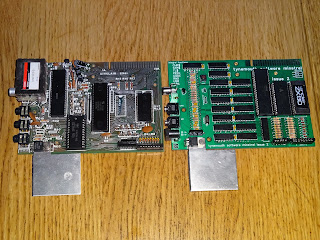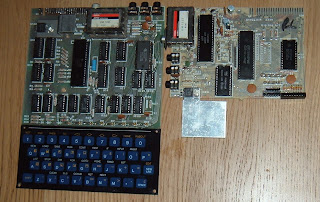.
Sinclair's ZX80 machine was a
famously low-cost all-TTL computer. The video out was driven by the Z80, not entirely unlike
Lancaster's video trick, but also using the Z80's refresh counter register to provide sequential addresses. Because of very low RAM - just 1k - a display list approach is used, so the space at the end of a line uses no storage. The CPU executes NOPs during active display, so the Basic disables the display while it's computing, as a tradeoff. The successor machine, the ZX81, aka Timex Sinclair 1000, added a SLOW mode to allow for a stable visible display even while computing.
Grant Searle has investigated, and has some
excellent annotated oscilloscope traces:

Dave Curran of Tynemouth Software has recently made
a kit called the Minstrel which recreates the ZX80 in all its TTL glory - here the 16k Minstrel is compared to the ZX81 with its custom chip which mops up all the glue:

And here's the original ZX80 compared to the ZX81:

(Worth a look at
all related posts especially perhaps
this one on improving the video output)

